This project was an attempt to build a telescope for terrestrial and celestial observations, to learn about the distinction between Keplerian and Galilean lens arrangements, and to test the impact of lens size. It uses commercially manufactured lenses, and a combination of 3D printed alignment guides for the lenses and three steel rods to hold the lenses along one axis. The top rod is hollow and can be used for coarse positioning of the telescope by looking through it, while the two bottom rods are solid providing increased rigidity and a counterweight for the heavy primary lens. The assembly is attached to a tripod with a 3D printed mount and aluminum backing plates for increased rigidity. The primary lens is a 6 inch diameter air spaced doublet, and the secondary may be a diverging lens for Galilean type, or a converging lens (with double reflection prism) for Keplerian type optical path.
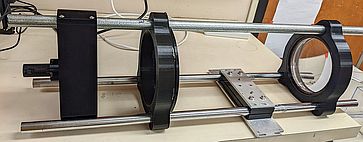
A side view of the telescope, showing the 3 metal rods and black 3D printed lens holders.
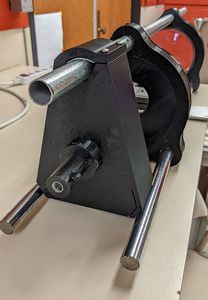
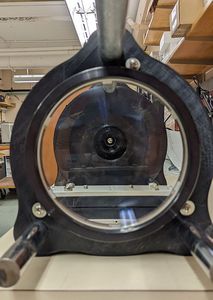
View from the eyepiece and from the front (primary) lens.
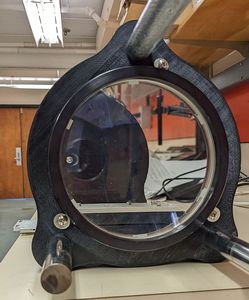
View through the front lens at an angle, showing that the internal baffle structure has holes with diameters such that at the lens edge the projected circles of the eyepiece and the baffle touch at the outermost points.
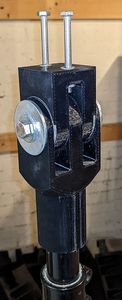
The 3D printed tripod mount used to hold the telescope. It is attached near the center of gravity, so there is a minimal force required to keep the telescope from tilting. Large metal washers are inserted in the 3D printed hinge, to spread the compressive force and provide a relatively smooth surface of controllable friction, with the bolt passing through the hinge providing adjustable preload.
As a comparison of optical quality, I also purchased a portable spotting scope (Celestron Ultima 80) which has an 80 mm primary lens (vs 152 mm in this project), and used some camera zoom lenses. The magnification was about 35x with the converging-diverging arrangement, and about 80x with the converging-converging arrangement. It should be noted that with converging-diverging, there is no need for a set of mirrors to generate an upright image, however this comes at the cost of a limited field of view. Looking through the eyepiece, the field of view is similar to that of looking through a circle the diameter of the front (primary) lens at its distance from the observer (or, as if removing all lenses and looking through the telescope tube). This is a characteristic of Galilean telescopes. This is illustrated in the photo below, taken through the eyepiece. Here the front lens is quite large, so the field of view is adequate to cover the highest resolution part of the retina. After some acclimatization it doesn't feel quite as limited as the photo below suggests. All the lenses are old parts from past systems, so I had limited flexibility in picking their parameters, otherwise I would have designed for a higher field of view with a converging lens at the eyepiece.
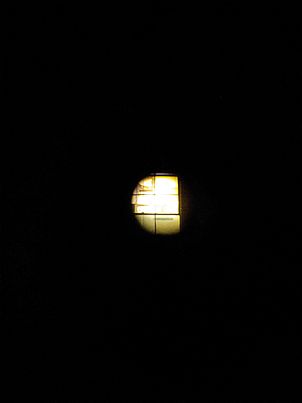
A photo taken with a cell phone camera through the eyepiece, showing the limited field of view with the Galilean telescope.
The image resolution was not anywhere near the diffraction limit, due to both limited aberration correction in the optics and limited quality of lens alignment with the 3D printed parts. With the lower 35x magnification, the image quality was better, because the diverging lens was higher quality, and because there was more light collected and passed through. In fact, with this magnification, the large primary lens allowed for the eye pupil to be the limiting aperture, meaning that objects through the telescope appear nearly as bright as looking at them directly. This is where the home-built telescope differentiates itself from the 80 mm spotting scope competitor. In the daytime, mounted on a tripod, the two perform similarly in terms of image quality and resolved detail, with perhaps a slight advantage of the home-built one. At night, however, the difference becomes substantial. The 80 mm scope, when taken to similar magnification, can only pass through a dimmer image, and it is difficult to make out many details. The home-built scope on the other hand passes a nearly identical brightness image, and the resulting contrast and color differentiation allows the observer to see a much clearer view, even with low levels of illumination such as moonlight. Overall I would say this project met its goals, but practically, one can get similar performance and a much more portable and robust form factor by just buying a commercially available scope such as the Celestron Ultima 80.